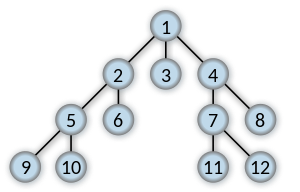다음 예에서와 같이 Breadth-First Search의 경로를 어떻게 추적합니까?

key를 검색하면 1에서 11까지 연결 11하는 가장 짧은 목록을 반환합니다 .
[1, 4, 7, 11]다음 예에서와 같이 Breadth-First Search의 경로를 어떻게 추적합니까?

key를 검색하면 1에서 11까지 연결 11하는 가장 짧은 목록을 반환합니다 .
[1, 4, 7, 11]답변:
먼저 http://en.wikipedia.org/wiki/Breadth-first_search를 봐야 합니다.
아래는 목록 목록을 사용하여 경로 대기열을 나타내는 빠른 구현입니다.
# graph is in adjacent list representation
graph = {
'1': ['2', '3', '4'],
'2': ['5', '6'],
'5': ['9', '10'],
'4': ['7', '8'],
'7': ['11', '12']
}
def bfs(graph, start, end):
# maintain a queue of paths
queue = []
# push the first path into the queue
queue.append([start])
while queue:
# get the first path from the queue
path = queue.pop(0)
# get the last node from the path
node = path[-1]
# path found
if node == end:
return path
# enumerate all adjacent nodes, construct a new path and push it into the queue
for adjacent in graph.get(node, []):
new_path = list(path)
new_path.append(adjacent)
queue.append(new_path)
print bfs(graph, '1', '11')또 다른 접근 방식은 각 노드에서 부모로의 매핑을 유지하고 인접 노드를 검사 할 때 부모를 기록하는 것입니다. 검색이 완료되면 상위 매핑에 따라 역 추적하면됩니다.
graph = {
'1': ['2', '3', '4'],
'2': ['5', '6'],
'5': ['9', '10'],
'4': ['7', '8'],
'7': ['11', '12']
}
def backtrace(parent, start, end):
path = [end]
while path[-1] != start:
path.append(parent[path[-1]])
path.reverse()
return path
def bfs(graph, start, end):
parent = {}
queue = []
queue.append(start)
while queue:
node = queue.pop(0)
if node == end:
return backtrace(parent, start, end)
for adjacent in graph.get(node, []):
if node not in queue :
parent[adjacent] = node # <<<<< record its parent
queue.append(adjacent)
print bfs(graph, '1', '11')위의 코드는 사이클이 없다는 가정을 기반으로합니다.
나는 qiao의 첫 번째 대답을 매우 좋아했습니다! 여기서 빠진 유일한 것은 꼭지점을 방문한 것으로 표시하는 것입니다.
왜해야합니까?
노드 11에서 연결된 다른 노드 번호 13이 있다고 가정 해
봅시다 . 이제 우리의 목표는 노드 13을 찾는 것입니다 . 약간의 실행 후 큐는 다음과 같이 보일 것입니다.
[[1, 2, 6], [1, 3, 10], [1, 4, 7], [1, 4, 8], [1, 2, 5, 9], [1, 2, 5, 10]]끝에 노드 번호가 10 인 경로가 두 개 있습니다.
즉, 노드 번호 10의 경로가 두 번 확인됩니다. 이 경우에는 10 번 노드에 자식이 없기 때문에 그렇게 나쁘게 보이지는 않습니다.하지만 정말 나쁠 수 있습니다 (여기서도 이유없이 해당 노드를 두 번 확인합니다.)
노드 13 번이 없습니다. 마지막에 노드 번호가 10 인 두 번째 경로에 도달하기 전에 프로그램이 반환되지 않도록 해당 경로를 다시 확인합니다.
우리가 놓친 것은 방문한 노드를 표시하고 다시 확인하지 않도록 설정하는 것입니다.
이것은 수정 후 qiao의 코드입니다.
graph = {
1: [2, 3, 4],
2: [5, 6],
3: [10],
4: [7, 8],
5: [9, 10],
7: [11, 12],
11: [13]
}
def bfs(graph_to_search, start, end):
queue = [[start]]
visited = set()
while queue:
# Gets the first path in the queue
path = queue.pop(0)
# Gets the last node in the path
vertex = path[-1]
# Checks if we got to the end
if vertex == end:
return path
# We check if the current node is already in the visited nodes set in order not to recheck it
elif vertex not in visited:
# enumerate all adjacent nodes, construct a new path and push it into the queue
for current_neighbour in graph_to_search.get(vertex, []):
new_path = list(path)
new_path.append(current_neighbour)
queue.append(new_path)
# Mark the vertex as visited
visited.add(vertex)
print bfs(graph, 1, 13)프로그램의 출력은 다음과 같습니다.
[1, 4, 7, 11, 13]불충분 한 재확인없이 ..
collections.deque에 대한 queuelist.pop로 (0)이 발생할 O(n)메모리 운동. 또한 후손을 위해 DFS를 수행 path = queue.pop()하려면 변수가 queue실제로 stack.
매우 쉬운 코드. 노드를 발견 할 때마다 계속 경로를 추가합니다.
graph = {
'A': set(['B', 'C']),
'B': set(['A', 'D', 'E']),
'C': set(['A', 'F']),
'D': set(['B']),
'E': set(['B', 'F']),
'F': set(['C', 'E'])
}
def retunShortestPath(graph, start, end):
queue = [(start,[start])]
visited = set()
while queue:
vertex, path = queue.pop(0)
visited.add(vertex)
for node in graph[vertex]:
if node == end:
return path + [end]
else:
if node not in visited:
visited.add(node)
queue.append((node, path + [node]))나는 이것을 재미로 코딩하려고 생각했다.
graph = {
'1': ['2', '3', '4'],
'2': ['5', '6'],
'5': ['9', '10'],
'4': ['7', '8'],
'7': ['11', '12']
}
def bfs(graph, forefront, end):
# assumes no cycles
next_forefront = [(node, path + ',' + node) for i, path in forefront if i in graph for node in graph[i]]
for node,path in next_forefront:
if node==end:
return path
else:
return bfs(graph,next_forefront,end)
print bfs(graph,[('1','1')],'11')
# >>>
# 1, 4, 7, 11주기를 원한다면 다음을 추가 할 수 있습니다.
for i, j in for_front: # allow cycles, add this code
if i in graph:
del graph[i]나는 @Qiao 첫 번째 답변과 @Or의 추가를 모두 좋아합니다. 약간의 처리를 위해 Or의 답변에 추가하고 싶습니다.
@Or의 답변에서 방문한 노드를 추적하는 것은 좋습니다. 또한 프로그램이 현재보다 빨리 종료되도록 할 수 있습니다. for 루프의 어느 시점에서는 current_neighbour이어야하며 end, 일단 발생하면 최단 경로가 발견되고 프로그램이 반환 될 수 있습니다.
다음과 같이 메서드를 수정하고 for 루프에 세심한주의를 기울입니다.
graph = {
1: [2, 3, 4],
2: [5, 6],
3: [10],
4: [7, 8],
5: [9, 10],
7: [11, 12],
11: [13]
}
def bfs(graph_to_search, start, end):
queue = [[start]]
visited = set()
while queue:
# Gets the first path in the queue
path = queue.pop(0)
# Gets the last node in the path
vertex = path[-1]
# Checks if we got to the end
if vertex == end:
return path
# We check if the current node is already in the visited nodes set in order not to recheck it
elif vertex not in visited:
# enumerate all adjacent nodes, construct a new path and push it into the queue
for current_neighbour in graph_to_search.get(vertex, []):
new_path = list(path)
new_path.append(current_neighbour)
queue.append(new_path)
#No need to visit other neighbour. Return at once
if current_neighbour == end
return new_path;
# Mark the vertex as visited
visited.add(vertex)
print bfs(graph, 1, 13)출력과 다른 모든 것은 동일합니다. 그러나 코드를 처리하는 데 시간이 덜 걸립니다. 이것은 큰 그래프에서 특히 유용합니다. 나는 이것이 미래의 누군가에게 도움이되기를 바랍니다.